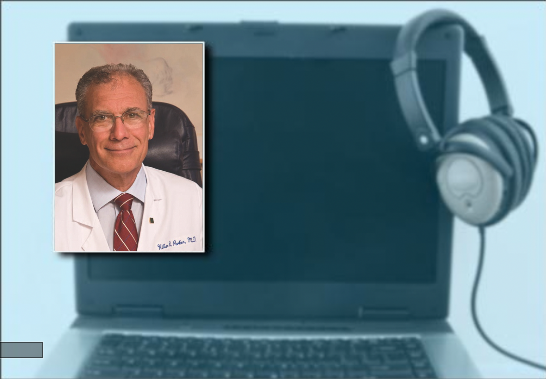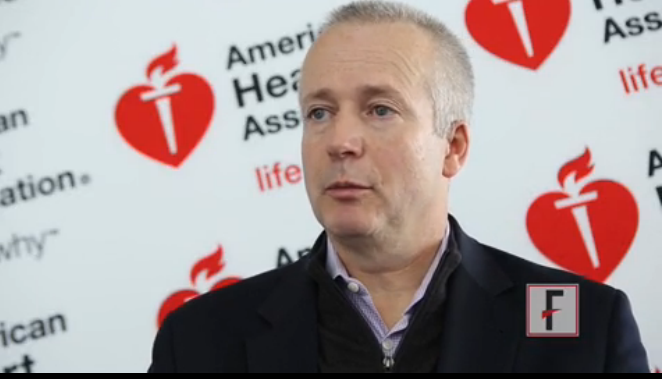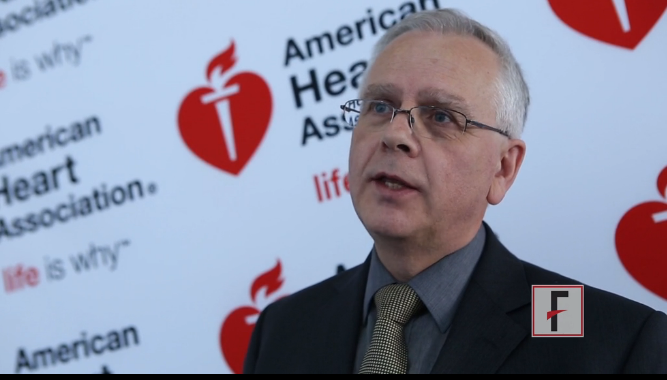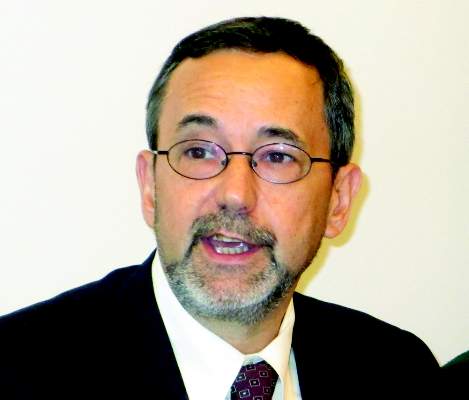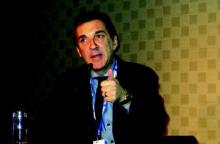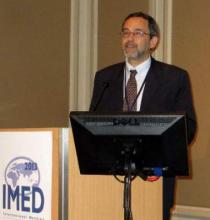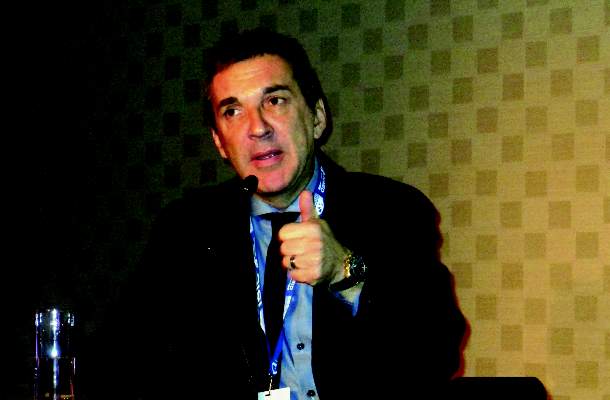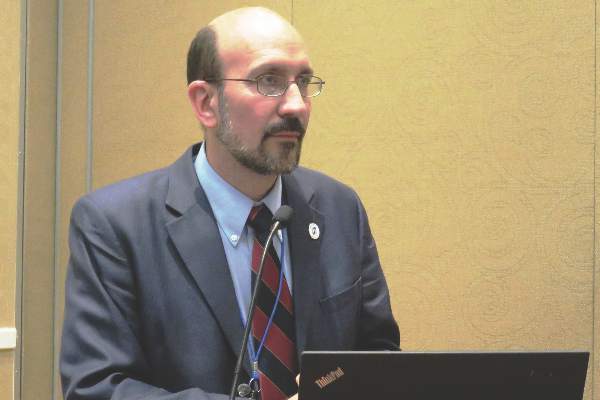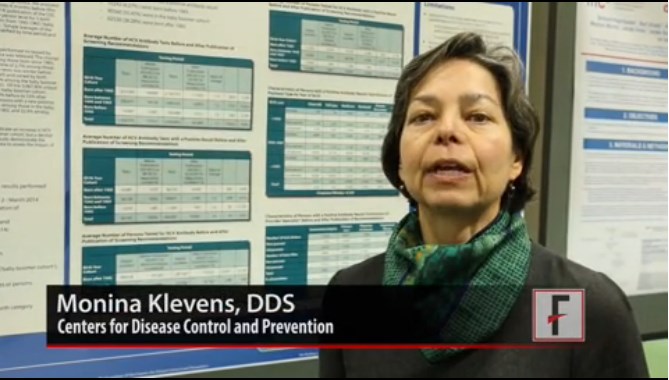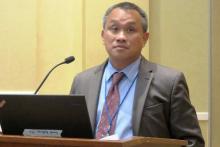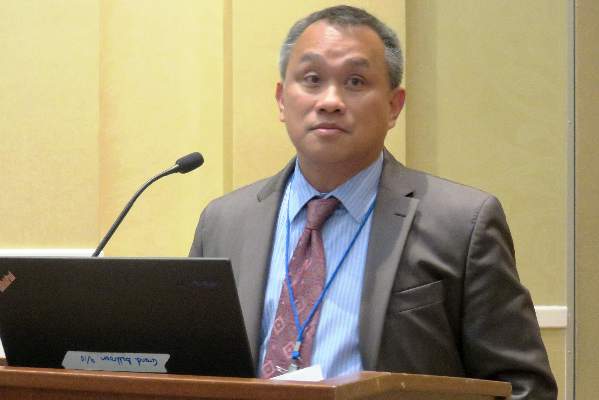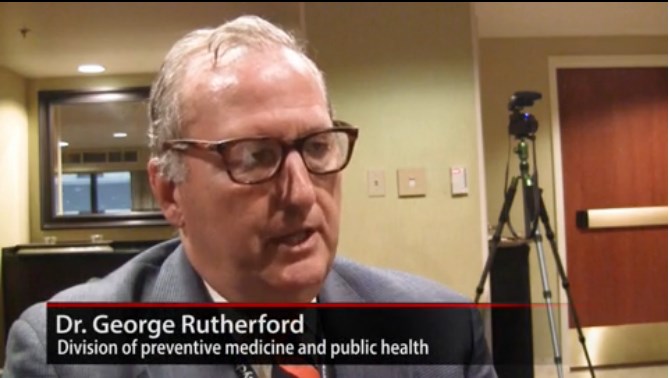User login
The FDA’s review of the data on open power morcellation was “inadequate, irresponsible” and a “disservice to women”
VIDEO: Bioabsorbable polymer stents offer improved deliverability
CHICAGO – Two new types of drug-eluting, biodegradable polymer stents weren’t inferior to current drug-eluting stents, and they possibly may have caused fewer stent thrombosis episodes.
But do the new stents reduce the risk of long-term stent thrombosis? How will their ease of use affect choice of stents? And how should long-term coronary events that aren’t related to the stents themselves shape approaches to secondary prevention?
In an interview at the American Heart Association scientific sessions, Dr. Robert Harrington shared his perspectives on these questions and connected the stent studies’ results with new findings in prevention research.
The two studies of the new stents were not large enough, nor were patients followed long enough, to prove an advantage in stent thrombosis rates in a definitive way. But the lead investigator in the everolimus-eluting Synergy stent study described the stent as more flexible and deliverable than current coronary stents.
Those usability features may make that stent an attractive option for interventional cardiologists even if clinical outcomes are not significantly improved, Dr. Harrington noted.
“These technical features, such as improved deliverability, are things that will resonate with the interventional community,” he said. “It offers another option for complex cases, and that appeals greatly to interventional cardiologists who are looking for technical solutions,” said Dr. Harrington, professor and chairman of medicine at Stanford (Calif.) University.
Dr. Harrington said that he had no disclosures regarding the studied stents, but he has received grants from several drug companies that market drugs used during and after patients undergo percutaneous coronary interventions.
On Twitter @mitchelzoler
The video associated with this article is no longer available on this site. Please view all of our videos on the MDedge YouTube channel
CHICAGO – Two new types of drug-eluting, biodegradable polymer stents weren’t inferior to current drug-eluting stents, and they possibly may have caused fewer stent thrombosis episodes.
But do the new stents reduce the risk of long-term stent thrombosis? How will their ease of use affect choice of stents? And how should long-term coronary events that aren’t related to the stents themselves shape approaches to secondary prevention?
In an interview at the American Heart Association scientific sessions, Dr. Robert Harrington shared his perspectives on these questions and connected the stent studies’ results with new findings in prevention research.
The two studies of the new stents were not large enough, nor were patients followed long enough, to prove an advantage in stent thrombosis rates in a definitive way. But the lead investigator in the everolimus-eluting Synergy stent study described the stent as more flexible and deliverable than current coronary stents.
Those usability features may make that stent an attractive option for interventional cardiologists even if clinical outcomes are not significantly improved, Dr. Harrington noted.
“These technical features, such as improved deliverability, are things that will resonate with the interventional community,” he said. “It offers another option for complex cases, and that appeals greatly to interventional cardiologists who are looking for technical solutions,” said Dr. Harrington, professor and chairman of medicine at Stanford (Calif.) University.
Dr. Harrington said that he had no disclosures regarding the studied stents, but he has received grants from several drug companies that market drugs used during and after patients undergo percutaneous coronary interventions.
On Twitter @mitchelzoler
The video associated with this article is no longer available on this site. Please view all of our videos on the MDedge YouTube channel
CHICAGO – Two new types of drug-eluting, biodegradable polymer stents weren’t inferior to current drug-eluting stents, and they possibly may have caused fewer stent thrombosis episodes.
But do the new stents reduce the risk of long-term stent thrombosis? How will their ease of use affect choice of stents? And how should long-term coronary events that aren’t related to the stents themselves shape approaches to secondary prevention?
In an interview at the American Heart Association scientific sessions, Dr. Robert Harrington shared his perspectives on these questions and connected the stent studies’ results with new findings in prevention research.
The two studies of the new stents were not large enough, nor were patients followed long enough, to prove an advantage in stent thrombosis rates in a definitive way. But the lead investigator in the everolimus-eluting Synergy stent study described the stent as more flexible and deliverable than current coronary stents.
Those usability features may make that stent an attractive option for interventional cardiologists even if clinical outcomes are not significantly improved, Dr. Harrington noted.
“These technical features, such as improved deliverability, are things that will resonate with the interventional community,” he said. “It offers another option for complex cases, and that appeals greatly to interventional cardiologists who are looking for technical solutions,” said Dr. Harrington, professor and chairman of medicine at Stanford (Calif.) University.
Dr. Harrington said that he had no disclosures regarding the studied stents, but he has received grants from several drug companies that market drugs used during and after patients undergo percutaneous coronary interventions.
On Twitter @mitchelzoler
The video associated with this article is no longer available on this site. Please view all of our videos on the MDedge YouTube channel
EXPERT ANALYSIS FROM THE AHA SCIENTIFIC SESSIONS
VIDEO: Study reignites dental antibiotic prophylaxis controversy
CHICAGO – The first guidelines recommending antibiotic prophylaxis for invasive dental procedures were issued in 1955, and controversy has gone hand in hand with each revision that has called for shorter treatment duration and fewer eligible patients.
A study presented at the American Heart Association scientific sessions adds to that controversy – and has prompted the United Kingdom’s National Institute for Health and Care Excellence to immediately review its 2008 guidelines.
Those guidelines recommend that antibiotics should not be prescribed to prevent infective endocarditis (IE) for people undergoing dental procedures or procedures in the upper and lower gastrointestinal tract, genitourinary tract, and upper and lower respiratory tract.
Five years post NICE, the new study found that antibiotic prophylaxis prescribing fell almost 90% in the United Kingdom, from 10,900 prescriptions per month to 1,307 per month in the last 6 months of the study, reported Dr. Mark Dayer of Taunton and Somerset NHS Trust, Somerset, England. The study was simultaneously published in the Lancet (2014 Nov. 18[doi:10.1016/S0140-6736(14)62007-9]).
In a video interview, study coauthor Dr. Martin Thornhill of the University of Sheffield, England, and AHA President-Elect Dr. Mark Creager, director of the vascular center at Brigham and Women’s Hospital, Boston, talked about the findings, their potential limitations, and whether it’s time for clinicians to change their approach to antibiotic prophylaxis.
The study was funded by the National Institutes of Dental and Cranofacial Research, Heart Research–UK, and Simplyhealth. Dr. Thornhill and Dr. Creager reported no conflicting interests.
CHICAGO – The first guidelines recommending antibiotic prophylaxis for invasive dental procedures were issued in 1955, and controversy has gone hand in hand with each revision that has called for shorter treatment duration and fewer eligible patients.
A study presented at the American Heart Association scientific sessions adds to that controversy – and has prompted the United Kingdom’s National Institute for Health and Care Excellence to immediately review its 2008 guidelines.
Those guidelines recommend that antibiotics should not be prescribed to prevent infective endocarditis (IE) for people undergoing dental procedures or procedures in the upper and lower gastrointestinal tract, genitourinary tract, and upper and lower respiratory tract.
Five years post NICE, the new study found that antibiotic prophylaxis prescribing fell almost 90% in the United Kingdom, from 10,900 prescriptions per month to 1,307 per month in the last 6 months of the study, reported Dr. Mark Dayer of Taunton and Somerset NHS Trust, Somerset, England. The study was simultaneously published in the Lancet (2014 Nov. 18[doi:10.1016/S0140-6736(14)62007-9]).
In a video interview, study coauthor Dr. Martin Thornhill of the University of Sheffield, England, and AHA President-Elect Dr. Mark Creager, director of the vascular center at Brigham and Women’s Hospital, Boston, talked about the findings, their potential limitations, and whether it’s time for clinicians to change their approach to antibiotic prophylaxis.
The study was funded by the National Institutes of Dental and Cranofacial Research, Heart Research–UK, and Simplyhealth. Dr. Thornhill and Dr. Creager reported no conflicting interests.
CHICAGO – The first guidelines recommending antibiotic prophylaxis for invasive dental procedures were issued in 1955, and controversy has gone hand in hand with each revision that has called for shorter treatment duration and fewer eligible patients.
A study presented at the American Heart Association scientific sessions adds to that controversy – and has prompted the United Kingdom’s National Institute for Health and Care Excellence to immediately review its 2008 guidelines.
Those guidelines recommend that antibiotics should not be prescribed to prevent infective endocarditis (IE) for people undergoing dental procedures or procedures in the upper and lower gastrointestinal tract, genitourinary tract, and upper and lower respiratory tract.
Five years post NICE, the new study found that antibiotic prophylaxis prescribing fell almost 90% in the United Kingdom, from 10,900 prescriptions per month to 1,307 per month in the last 6 months of the study, reported Dr. Mark Dayer of Taunton and Somerset NHS Trust, Somerset, England. The study was simultaneously published in the Lancet (2014 Nov. 18[doi:10.1016/S0140-6736(14)62007-9]).
In a video interview, study coauthor Dr. Martin Thornhill of the University of Sheffield, England, and AHA President-Elect Dr. Mark Creager, director of the vascular center at Brigham and Women’s Hospital, Boston, talked about the findings, their potential limitations, and whether it’s time for clinicians to change their approach to antibiotic prophylaxis.
The study was funded by the National Institutes of Dental and Cranofacial Research, Heart Research–UK, and Simplyhealth. Dr. Thornhill and Dr. Creager reported no conflicting interests.
AT THE AHA SCIENTIFIC SESSIONS
Participatory surveillance gains ground in U.S., Brazil
VIENNA – Participatory surveillance has begun to enter mainstream public health.
The Brazilian Ministry of Health arranged for distribution of a participatory surveillance app for monitoring 10 symptoms in people attending or working at 2014 FIFA World Cup events. The smart phone app had 9,434 downloads, 7,155 registered users, and 4,706 active users who sent a message about their symptom status at least three times during the World Cup last June and July in Brazil, Dr. Marlo Libel said at the International Meeting on Emerging Diseases and Surveillance. “Healthy Cup 2014” became the first participatory surveillance tool ever used at a mass gathering event, he said.
“We demonstrated that direct self-reporting during a short period of time could be an excellent tool to complement other surveillance activities,” said Dr. Libel, a medical epidemiology consultant who worked with the Skoll Global Threats Fund on the Brazilian project. Officials at the Brazilian Ministry of Health were so pleased with the program that they are planning with Skoll to release similar apps for Carnival in Feb. 2015 and then for the 2016 Summer Olympics, Dr. Libel said.
Flu Near You shows U.S. growth
Longer-term participatory surveillance of U.S. residents began with the launch of the Flu Near You program in 2012, and by October 2014 it had roughly 100,000 U.S. participants, said John S. Brownstein, Ph.D., an epidemiologist at Harvard Medical School in Boston and cofounder of Flu Near You.
That level is large enough to provide meaningful information, according to Matthew Biggerstaff, an epidemiologist at the Centers for Disease Control and Prevention in Atlanta, as well as other public health officials.
“We’ve been really excited at CDC about Flu Near You because it gives us a view of influenza illness that goes beyond the medically attended cases we base our usual surveillance on,” said Matthew Biggerstaff, an epidemiologist in the CDC’s influenza division. “It adds timeliness because we usually have a 1-week lag” in reporting data from outpatient physician visits and hospitalizations. Flu Near You, which asks participants to report weekly on whether they have any of 10 symptoms gives information that goes beyond the flu-like illness tallied by standard CDC surveillance. “We do not think that it will replace our traditional health care–based surveillance, but it gives us another set of data to look at,” Mr. Biggerstaff said in an interview.
The 10 symptoms that Flu Near You prompts users to report on each week are fever, cough, sore throat, shortness of breath, chills or night sweats, fatigue, nausea and vomiting, diarrhea, body ache, and headache. New participants are also asked whether they received a flu shot during the prior season, Aug. 1-July 31, as well as during the current season since the most recent July 31.
Flu Near You and other participatory surveillance tools also offer epidemiologists a way to track the participating cohort over time. That allows assessment of individual attack rates of influenza-like illness and other syndromes and also vaccine efficacy, Mr. Biggerstaff noted.
“It helps give us a feel for what is happening” with influenza. “We have worked with Flu Near You in the past and we continue to think about ways to work together on digital disease surveillance. We promote it to our state and local colleagues. We think it is a good resource for states to have,” he sad. The CDC’s influenza division is also assessing and using other novel forms of surveillance data, such as influenza and flu mentions on Twitter and searches on Google as well as a statistic Google maintains as Flu Trends.
Participatory surveillance is “very exciting” but is also “new and unproven and remains an experiment,” said Dr. Lawrence C. Madoff, director of the division of epidemiology and immunization at the Massachusetts Department of Public Health in Boston. But while participatory surveillance must still prove its role, U.S. public health officials “increasingly” accept the value of data from tools like Flu Near You, Dr. Madoff said in an interview. He cited the endorsement that participatory surveillance received in recent surveillance and early-detection recommendations from the World Health Organization. The 100,000 participants in Flu Near You give it a “critical mass that will become even more robust as it continues to grow,” Dr. Madoff said.
Further growth is clearly a priority for Flu Near You. “We’re now very excited to promote Flu Near You in a big way to try to get more numbers there and see if we can have a faster system for picking up influenza,” said Dr. Mark S. Smolinski, director of global health at Skoll.
“We are still trying to think through how do we get [Flu Near You] into the general consciousness” of more Americans, said Dr. Brownstein. While participants, not all of whom are active every week, provide enough data to show good correlation with the CDC’s routine surveillance on a national scale, if Flu Near You “had enough numbers we could drill down into subpopulations,” he noted. For now, the volume of participation makes subgroups too scanty in size for meaningful analysis, Dr. Brownstein conceded.
Mass gathering surveillance in Brazil
The Brazilian surveillance program at the World Cup was modeled on Flu Near You, but Dr. Libel, Dr. Smolinski, and their collaborators produced the app in about 8 weeks after receiving very short notice of the Brazilians’ interest. The weekly, symptom surveillance questions posed by the app replicated seven symptoms from Flu Near You – fever, cough, sore throat, shortness of breath, nausea and vomiting, diarrhea, and headache – and added three new symptoms to the survey: joint pain, bleeding, and red spots on body. This allowed the Health Ministry to also monitor for outbreaks of other infections including measles, cholera, dengue, and chikungunya, Dr. Libel said. The Brazilian app also asked participants each week whether they had been in contact with anyone who had any of the 10 listed symptoms, and whether they had looked for health care services. No outbreaks of any type occurred in Brazil during the World Cup, but during the period it was actively used 27% of the frequent respondents reported experiencing at least one symptom.
The first Brazilian effort “was basically a pilot program,” with little advance promotion, Dr. Smolinksi said in an interview. Officials of the Brazilian Ministry of Health were “impressed” with the data collected. They also liked the ability of the system to push out information on health care access to registered users, and the potential the app offered to send out urgent public health messages. “What the Health Ministry loved the most was that if there had been an outbreak they could have immediately reached out to fans,” Dr. Smolinski said.
The Ministry has interest in expanded surveillance and outreach programs for Carnival and the 2016 Summer Olympics, and Dr. Smolinski and his associates are hopeful that the International Olympics Committee will be receptive to the program and aid in its promotion during 2016. They are also planning to expand beyond smart phones and include the capability to interact with users via text and voice messages.
“We hope we will have huge numbers at the Olympics,” to better document the role participatory surveillance can play at mass gatherings, Dr. Smolinski said.
Dr. Libel, Dr. Brownstein, Mr. Biggerstaff, Dr. Smolinski, and Dr. Madoff had no disclosures.
On Twitter @mitchelzoler
VIENNA – Participatory surveillance has begun to enter mainstream public health.
The Brazilian Ministry of Health arranged for distribution of a participatory surveillance app for monitoring 10 symptoms in people attending or working at 2014 FIFA World Cup events. The smart phone app had 9,434 downloads, 7,155 registered users, and 4,706 active users who sent a message about their symptom status at least three times during the World Cup last June and July in Brazil, Dr. Marlo Libel said at the International Meeting on Emerging Diseases and Surveillance. “Healthy Cup 2014” became the first participatory surveillance tool ever used at a mass gathering event, he said.
“We demonstrated that direct self-reporting during a short period of time could be an excellent tool to complement other surveillance activities,” said Dr. Libel, a medical epidemiology consultant who worked with the Skoll Global Threats Fund on the Brazilian project. Officials at the Brazilian Ministry of Health were so pleased with the program that they are planning with Skoll to release similar apps for Carnival in Feb. 2015 and then for the 2016 Summer Olympics, Dr. Libel said.
Flu Near You shows U.S. growth
Longer-term participatory surveillance of U.S. residents began with the launch of the Flu Near You program in 2012, and by October 2014 it had roughly 100,000 U.S. participants, said John S. Brownstein, Ph.D., an epidemiologist at Harvard Medical School in Boston and cofounder of Flu Near You.
That level is large enough to provide meaningful information, according to Matthew Biggerstaff, an epidemiologist at the Centers for Disease Control and Prevention in Atlanta, as well as other public health officials.
“We’ve been really excited at CDC about Flu Near You because it gives us a view of influenza illness that goes beyond the medically attended cases we base our usual surveillance on,” said Matthew Biggerstaff, an epidemiologist in the CDC’s influenza division. “It adds timeliness because we usually have a 1-week lag” in reporting data from outpatient physician visits and hospitalizations. Flu Near You, which asks participants to report weekly on whether they have any of 10 symptoms gives information that goes beyond the flu-like illness tallied by standard CDC surveillance. “We do not think that it will replace our traditional health care–based surveillance, but it gives us another set of data to look at,” Mr. Biggerstaff said in an interview.
The 10 symptoms that Flu Near You prompts users to report on each week are fever, cough, sore throat, shortness of breath, chills or night sweats, fatigue, nausea and vomiting, diarrhea, body ache, and headache. New participants are also asked whether they received a flu shot during the prior season, Aug. 1-July 31, as well as during the current season since the most recent July 31.
Flu Near You and other participatory surveillance tools also offer epidemiologists a way to track the participating cohort over time. That allows assessment of individual attack rates of influenza-like illness and other syndromes and also vaccine efficacy, Mr. Biggerstaff noted.
“It helps give us a feel for what is happening” with influenza. “We have worked with Flu Near You in the past and we continue to think about ways to work together on digital disease surveillance. We promote it to our state and local colleagues. We think it is a good resource for states to have,” he sad. The CDC’s influenza division is also assessing and using other novel forms of surveillance data, such as influenza and flu mentions on Twitter and searches on Google as well as a statistic Google maintains as Flu Trends.
Participatory surveillance is “very exciting” but is also “new and unproven and remains an experiment,” said Dr. Lawrence C. Madoff, director of the division of epidemiology and immunization at the Massachusetts Department of Public Health in Boston. But while participatory surveillance must still prove its role, U.S. public health officials “increasingly” accept the value of data from tools like Flu Near You, Dr. Madoff said in an interview. He cited the endorsement that participatory surveillance received in recent surveillance and early-detection recommendations from the World Health Organization. The 100,000 participants in Flu Near You give it a “critical mass that will become even more robust as it continues to grow,” Dr. Madoff said.
Further growth is clearly a priority for Flu Near You. “We’re now very excited to promote Flu Near You in a big way to try to get more numbers there and see if we can have a faster system for picking up influenza,” said Dr. Mark S. Smolinski, director of global health at Skoll.
“We are still trying to think through how do we get [Flu Near You] into the general consciousness” of more Americans, said Dr. Brownstein. While participants, not all of whom are active every week, provide enough data to show good correlation with the CDC’s routine surveillance on a national scale, if Flu Near You “had enough numbers we could drill down into subpopulations,” he noted. For now, the volume of participation makes subgroups too scanty in size for meaningful analysis, Dr. Brownstein conceded.
Mass gathering surveillance in Brazil
The Brazilian surveillance program at the World Cup was modeled on Flu Near You, but Dr. Libel, Dr. Smolinski, and their collaborators produced the app in about 8 weeks after receiving very short notice of the Brazilians’ interest. The weekly, symptom surveillance questions posed by the app replicated seven symptoms from Flu Near You – fever, cough, sore throat, shortness of breath, nausea and vomiting, diarrhea, and headache – and added three new symptoms to the survey: joint pain, bleeding, and red spots on body. This allowed the Health Ministry to also monitor for outbreaks of other infections including measles, cholera, dengue, and chikungunya, Dr. Libel said. The Brazilian app also asked participants each week whether they had been in contact with anyone who had any of the 10 listed symptoms, and whether they had looked for health care services. No outbreaks of any type occurred in Brazil during the World Cup, but during the period it was actively used 27% of the frequent respondents reported experiencing at least one symptom.
The first Brazilian effort “was basically a pilot program,” with little advance promotion, Dr. Smolinksi said in an interview. Officials of the Brazilian Ministry of Health were “impressed” with the data collected. They also liked the ability of the system to push out information on health care access to registered users, and the potential the app offered to send out urgent public health messages. “What the Health Ministry loved the most was that if there had been an outbreak they could have immediately reached out to fans,” Dr. Smolinski said.
The Ministry has interest in expanded surveillance and outreach programs for Carnival and the 2016 Summer Olympics, and Dr. Smolinski and his associates are hopeful that the International Olympics Committee will be receptive to the program and aid in its promotion during 2016. They are also planning to expand beyond smart phones and include the capability to interact with users via text and voice messages.
“We hope we will have huge numbers at the Olympics,” to better document the role participatory surveillance can play at mass gatherings, Dr. Smolinski said.
Dr. Libel, Dr. Brownstein, Mr. Biggerstaff, Dr. Smolinski, and Dr. Madoff had no disclosures.
On Twitter @mitchelzoler
VIENNA – Participatory surveillance has begun to enter mainstream public health.
The Brazilian Ministry of Health arranged for distribution of a participatory surveillance app for monitoring 10 symptoms in people attending or working at 2014 FIFA World Cup events. The smart phone app had 9,434 downloads, 7,155 registered users, and 4,706 active users who sent a message about their symptom status at least three times during the World Cup last June and July in Brazil, Dr. Marlo Libel said at the International Meeting on Emerging Diseases and Surveillance. “Healthy Cup 2014” became the first participatory surveillance tool ever used at a mass gathering event, he said.
“We demonstrated that direct self-reporting during a short period of time could be an excellent tool to complement other surveillance activities,” said Dr. Libel, a medical epidemiology consultant who worked with the Skoll Global Threats Fund on the Brazilian project. Officials at the Brazilian Ministry of Health were so pleased with the program that they are planning with Skoll to release similar apps for Carnival in Feb. 2015 and then for the 2016 Summer Olympics, Dr. Libel said.
Flu Near You shows U.S. growth
Longer-term participatory surveillance of U.S. residents began with the launch of the Flu Near You program in 2012, and by October 2014 it had roughly 100,000 U.S. participants, said John S. Brownstein, Ph.D., an epidemiologist at Harvard Medical School in Boston and cofounder of Flu Near You.
That level is large enough to provide meaningful information, according to Matthew Biggerstaff, an epidemiologist at the Centers for Disease Control and Prevention in Atlanta, as well as other public health officials.
“We’ve been really excited at CDC about Flu Near You because it gives us a view of influenza illness that goes beyond the medically attended cases we base our usual surveillance on,” said Matthew Biggerstaff, an epidemiologist in the CDC’s influenza division. “It adds timeliness because we usually have a 1-week lag” in reporting data from outpatient physician visits and hospitalizations. Flu Near You, which asks participants to report weekly on whether they have any of 10 symptoms gives information that goes beyond the flu-like illness tallied by standard CDC surveillance. “We do not think that it will replace our traditional health care–based surveillance, but it gives us another set of data to look at,” Mr. Biggerstaff said in an interview.
The 10 symptoms that Flu Near You prompts users to report on each week are fever, cough, sore throat, shortness of breath, chills or night sweats, fatigue, nausea and vomiting, diarrhea, body ache, and headache. New participants are also asked whether they received a flu shot during the prior season, Aug. 1-July 31, as well as during the current season since the most recent July 31.
Flu Near You and other participatory surveillance tools also offer epidemiologists a way to track the participating cohort over time. That allows assessment of individual attack rates of influenza-like illness and other syndromes and also vaccine efficacy, Mr. Biggerstaff noted.
“It helps give us a feel for what is happening” with influenza. “We have worked with Flu Near You in the past and we continue to think about ways to work together on digital disease surveillance. We promote it to our state and local colleagues. We think it is a good resource for states to have,” he sad. The CDC’s influenza division is also assessing and using other novel forms of surveillance data, such as influenza and flu mentions on Twitter and searches on Google as well as a statistic Google maintains as Flu Trends.
Participatory surveillance is “very exciting” but is also “new and unproven and remains an experiment,” said Dr. Lawrence C. Madoff, director of the division of epidemiology and immunization at the Massachusetts Department of Public Health in Boston. But while participatory surveillance must still prove its role, U.S. public health officials “increasingly” accept the value of data from tools like Flu Near You, Dr. Madoff said in an interview. He cited the endorsement that participatory surveillance received in recent surveillance and early-detection recommendations from the World Health Organization. The 100,000 participants in Flu Near You give it a “critical mass that will become even more robust as it continues to grow,” Dr. Madoff said.
Further growth is clearly a priority for Flu Near You. “We’re now very excited to promote Flu Near You in a big way to try to get more numbers there and see if we can have a faster system for picking up influenza,” said Dr. Mark S. Smolinski, director of global health at Skoll.
“We are still trying to think through how do we get [Flu Near You] into the general consciousness” of more Americans, said Dr. Brownstein. While participants, not all of whom are active every week, provide enough data to show good correlation with the CDC’s routine surveillance on a national scale, if Flu Near You “had enough numbers we could drill down into subpopulations,” he noted. For now, the volume of participation makes subgroups too scanty in size for meaningful analysis, Dr. Brownstein conceded.
Mass gathering surveillance in Brazil
The Brazilian surveillance program at the World Cup was modeled on Flu Near You, but Dr. Libel, Dr. Smolinski, and their collaborators produced the app in about 8 weeks after receiving very short notice of the Brazilians’ interest. The weekly, symptom surveillance questions posed by the app replicated seven symptoms from Flu Near You – fever, cough, sore throat, shortness of breath, nausea and vomiting, diarrhea, and headache – and added three new symptoms to the survey: joint pain, bleeding, and red spots on body. This allowed the Health Ministry to also monitor for outbreaks of other infections including measles, cholera, dengue, and chikungunya, Dr. Libel said. The Brazilian app also asked participants each week whether they had been in contact with anyone who had any of the 10 listed symptoms, and whether they had looked for health care services. No outbreaks of any type occurred in Brazil during the World Cup, but during the period it was actively used 27% of the frequent respondents reported experiencing at least one symptom.
The first Brazilian effort “was basically a pilot program,” with little advance promotion, Dr. Smolinksi said in an interview. Officials of the Brazilian Ministry of Health were “impressed” with the data collected. They also liked the ability of the system to push out information on health care access to registered users, and the potential the app offered to send out urgent public health messages. “What the Health Ministry loved the most was that if there had been an outbreak they could have immediately reached out to fans,” Dr. Smolinski said.
The Ministry has interest in expanded surveillance and outreach programs for Carnival and the 2016 Summer Olympics, and Dr. Smolinski and his associates are hopeful that the International Olympics Committee will be receptive to the program and aid in its promotion during 2016. They are also planning to expand beyond smart phones and include the capability to interact with users via text and voice messages.
“We hope we will have huge numbers at the Olympics,” to better document the role participatory surveillance can play at mass gatherings, Dr. Smolinski said.
Dr. Libel, Dr. Brownstein, Mr. Biggerstaff, Dr. Smolinski, and Dr. Madoff had no disclosures.
On Twitter @mitchelzoler
EXPERT ANALYSIS FROM IMED 2014
Dr. Robert L. Barbieri’s Editor’s Picks November 2014
Editor in Chief Robert L. Barbieri, MD, provides an overview of three articles appearing in OBG Management’s November 2014 issue. Listen to his take on why these articles are of particular importance to women’s health professionals.
Access all of the articles in the November 2014 issue here.
Editor in Chief Robert L. Barbieri, MD, provides an overview of three articles appearing in OBG Management’s November 2014 issue. Listen to his take on why these articles are of particular importance to women’s health professionals.
Access all of the articles in the November 2014 issue here.
Editor in Chief Robert L. Barbieri, MD, provides an overview of three articles appearing in OBG Management’s November 2014 issue. Listen to his take on why these articles are of particular importance to women’s health professionals.
Access all of the articles in the November 2014 issue here.
Ebola entrenched in West Africa, recurrence inevitable
VIENNA – The world had better get used to dealing with Ebola virus outbreaks, because even if the west African outbreak comes under control others will inevitably follow until an effective vaccine becomes widely used.
On top of that, experts who gathered at the International Meeting on Emerging Disease and Surveillance said that they saw no quick end to the current west African outbreak.
“At this point, Ebola is so entrenched in west Africa that it will come back again. It is basically part of the [west African] ecology,” Dr. Adriano G. Duse said in an interview. He also painted a pessimistic picture of short-term prospects for controlling the current outbreak.
“It will be around [in west Africa] for at least the next year. There is no sign of it abating,” said Dr. Duse, professor and head of the department of clinical microbiology and infectious diseases at the University of Witwatersrand in Johannesburg, South Africa, and a specialist in viral hemorrhagic fevers. “We suspect that the [Ebola] virus has been around in west Africa for a long time, and it was just a matter of time until it went into people.” He noted that the Ebola species currently circulating in west Africa closely matches the Zaire strain that was the type that first surfaced in people in 1976.
“We are now so high in numbers in west Africa that it will take months” to control the current outbreak, agreed Dr. Hilde de Clerck, a family physician who serves as a mobile implementation officer for viral hemorrhagic fevers for Médicins Sans Frontières (MSF; Doctors Without Borders), who began working last March in Guinea on patient care and infection control. “At MSF, we are planning that it will take at least 6-12 months, but that is a guess; we have no clue” how long the current outbreak will continue, Dr. de Clerck said in an interview. “At this time, we are running behind.”
On Nov. 14, the World Health Organization (WHO) pegged the number of Ebola virus infections known to have occurred in Guinea, Sierra Leone, and Liberia as of Nov. 11 at 14,383 (with a total of 14,413 total infection worldwide since the outbreak began), with 5,165 Ebola fatalities in west Africa and 5,177 worldwide. Dr. de Clerck, Dr. Duse, and others said that they believe that the WHO’s numbers greatly underestimate the true scope of the outbreak, even though the official numbers dwarf the size of all prior Ebola virus outbreaks since the virus first emerged in 1976; previous outbreaks always involved fewer than 1,000 infected people.
“The numbers we have seen show that the WHO’s numbers can’t be right,” Dr. de Clerck said.
Factors fueling Ebola’s spread
Dr. de Clerck attributed the unprecedented spread of Ebola during this outbreak to the high mobility of the people who live in the region where Guinea, Sierra Leone, and Liberia share borders. She described people in the region who routinely travel as much as several hundred kilometers from one day to the next, and the easy flow of traffic from one country to another. She also cited as a major factor in the virus’s spread the large funerals traditionally held by the people in the region that typically involve contact with the body of the deceased.
But perhaps most important in the outbreak’s spread was a slow initial response to the first cases in the region. Dr. Duse criticized the governments of the three affected countries for their lax response to the onset of the outbreak, while he also praised Nigeria for taking a dramatically different tack.
The initial response to Ebola in Guinea and its neighboring countries was “denial” and “apathy,” and the responses also “lacked funding,” Dr. Duse said at the meeting. “It would have come to an end much sooner if the response had been mobilized quicker.” In contrast, the Nigerian response “was exceptionally swift,” and serves as a “role model for how to approach” future Ebola outbreaks.
Oyewale Tomori, D.V.M., Ph.D., president of the Nigerian Academy of Science, called the approach of many African countries to Ebola as “an ocean of apathy, denial, and unpreparedness.” In Nigeria, an Ebola management center opened 3 days after an Ebola-infected person arrived at Lagos airport from Liberia on July 20. That one case led to the infection of 20 other people, but the chain of infection stopped there, helped no doubt by a physician strike at the time which meant the index case went to a private hospital instead of a public hospital.
“We were lucky,” said Dr. Tomori. “We would have had a much bigger problem if the patient had gone to a teaching hospital.”
On Oct. 20, the WHO declared Nigeria Ebola free.
Ebola also spread this year in the Democratic Republic of Congo (DRC) starting in August, an outbreak documented as unrelated to the one in west Africa and resulting from a DRC resident eating Ebola-carrying bushmeat. In the DRC, a quick and thorough response contained the spread and appears to have brought the outbreak to an end. On Nov. 15, the DRC’s minister of health said that the outbreak was over.
The experience this year in both Nigeria and the DRC shows that “Ebola is completely preventable if you educate people on how to avoid it,” said William Karesh, D.V.M., executive vice president for health and policy at the EcoHealth Alliance in New York.
Prospects for the west African outbreak
Given Ebola’s spread now in west Africa, “it is incredibly daunting to isolate all the cases,” said Dr. Lawrence C. Madoff, a professor of medicine at the University of Massachusetts in Worcester and director of epidemiology and immunization at the Massachusetts Department of Public Health in Boston. “The infrastructure [in the affected west African countries] is missing, challenged, or stretched way too thin, and it’s been incredibly difficult,” but he added that eventually he expects the epidemic curve of Ebola to peak and fall.
“As a rule, outbreaks end, and I don’t see any reason why this outbreak won’t also end. Sometimes, like in the great plagues of the Middle Ages, they can go on for a long time and involve many people, but eventually they do end.”
Dr. Duse agreed, and cited Ebola’s high mortality rate as a factor that limits the duration of outbreaks. “There has never been an Ebola outbreak that was sustained,” he noted.
“Humans are not Ebola carriers; they either die or recover, and stop shedding virus and are immune,” noted Dr. Karesh. But even when the current outbreak in west Africa ends, the threat remains of new introductions of Ebola into people from the reservoirs of virus that exist in bats and primates. “By the time the west African outbreak is controlled, there could be other spillover events” from animals to people, he cautioned.
Dr. Duse, Dr. de Clerck, Dr. Tomori, Dr. Karesh, and Dr. Madoff had no disclosures.
On Twitter @mitchelzoler
VIENNA – The world had better get used to dealing with Ebola virus outbreaks, because even if the west African outbreak comes under control others will inevitably follow until an effective vaccine becomes widely used.
On top of that, experts who gathered at the International Meeting on Emerging Disease and Surveillance said that they saw no quick end to the current west African outbreak.
“At this point, Ebola is so entrenched in west Africa that it will come back again. It is basically part of the [west African] ecology,” Dr. Adriano G. Duse said in an interview. He also painted a pessimistic picture of short-term prospects for controlling the current outbreak.
“It will be around [in west Africa] for at least the next year. There is no sign of it abating,” said Dr. Duse, professor and head of the department of clinical microbiology and infectious diseases at the University of Witwatersrand in Johannesburg, South Africa, and a specialist in viral hemorrhagic fevers. “We suspect that the [Ebola] virus has been around in west Africa for a long time, and it was just a matter of time until it went into people.” He noted that the Ebola species currently circulating in west Africa closely matches the Zaire strain that was the type that first surfaced in people in 1976.
“We are now so high in numbers in west Africa that it will take months” to control the current outbreak, agreed Dr. Hilde de Clerck, a family physician who serves as a mobile implementation officer for viral hemorrhagic fevers for Médicins Sans Frontières (MSF; Doctors Without Borders), who began working last March in Guinea on patient care and infection control. “At MSF, we are planning that it will take at least 6-12 months, but that is a guess; we have no clue” how long the current outbreak will continue, Dr. de Clerck said in an interview. “At this time, we are running behind.”
On Nov. 14, the World Health Organization (WHO) pegged the number of Ebola virus infections known to have occurred in Guinea, Sierra Leone, and Liberia as of Nov. 11 at 14,383 (with a total of 14,413 total infection worldwide since the outbreak began), with 5,165 Ebola fatalities in west Africa and 5,177 worldwide. Dr. de Clerck, Dr. Duse, and others said that they believe that the WHO’s numbers greatly underestimate the true scope of the outbreak, even though the official numbers dwarf the size of all prior Ebola virus outbreaks since the virus first emerged in 1976; previous outbreaks always involved fewer than 1,000 infected people.
“The numbers we have seen show that the WHO’s numbers can’t be right,” Dr. de Clerck said.
Factors fueling Ebola’s spread
Dr. de Clerck attributed the unprecedented spread of Ebola during this outbreak to the high mobility of the people who live in the region where Guinea, Sierra Leone, and Liberia share borders. She described people in the region who routinely travel as much as several hundred kilometers from one day to the next, and the easy flow of traffic from one country to another. She also cited as a major factor in the virus’s spread the large funerals traditionally held by the people in the region that typically involve contact with the body of the deceased.
But perhaps most important in the outbreak’s spread was a slow initial response to the first cases in the region. Dr. Duse criticized the governments of the three affected countries for their lax response to the onset of the outbreak, while he also praised Nigeria for taking a dramatically different tack.
The initial response to Ebola in Guinea and its neighboring countries was “denial” and “apathy,” and the responses also “lacked funding,” Dr. Duse said at the meeting. “It would have come to an end much sooner if the response had been mobilized quicker.” In contrast, the Nigerian response “was exceptionally swift,” and serves as a “role model for how to approach” future Ebola outbreaks.
Oyewale Tomori, D.V.M., Ph.D., president of the Nigerian Academy of Science, called the approach of many African countries to Ebola as “an ocean of apathy, denial, and unpreparedness.” In Nigeria, an Ebola management center opened 3 days after an Ebola-infected person arrived at Lagos airport from Liberia on July 20. That one case led to the infection of 20 other people, but the chain of infection stopped there, helped no doubt by a physician strike at the time which meant the index case went to a private hospital instead of a public hospital.
“We were lucky,” said Dr. Tomori. “We would have had a much bigger problem if the patient had gone to a teaching hospital.”
On Oct. 20, the WHO declared Nigeria Ebola free.
Ebola also spread this year in the Democratic Republic of Congo (DRC) starting in August, an outbreak documented as unrelated to the one in west Africa and resulting from a DRC resident eating Ebola-carrying bushmeat. In the DRC, a quick and thorough response contained the spread and appears to have brought the outbreak to an end. On Nov. 15, the DRC’s minister of health said that the outbreak was over.
The experience this year in both Nigeria and the DRC shows that “Ebola is completely preventable if you educate people on how to avoid it,” said William Karesh, D.V.M., executive vice president for health and policy at the EcoHealth Alliance in New York.
Prospects for the west African outbreak
Given Ebola’s spread now in west Africa, “it is incredibly daunting to isolate all the cases,” said Dr. Lawrence C. Madoff, a professor of medicine at the University of Massachusetts in Worcester and director of epidemiology and immunization at the Massachusetts Department of Public Health in Boston. “The infrastructure [in the affected west African countries] is missing, challenged, or stretched way too thin, and it’s been incredibly difficult,” but he added that eventually he expects the epidemic curve of Ebola to peak and fall.
“As a rule, outbreaks end, and I don’t see any reason why this outbreak won’t also end. Sometimes, like in the great plagues of the Middle Ages, they can go on for a long time and involve many people, but eventually they do end.”
Dr. Duse agreed, and cited Ebola’s high mortality rate as a factor that limits the duration of outbreaks. “There has never been an Ebola outbreak that was sustained,” he noted.
“Humans are not Ebola carriers; they either die or recover, and stop shedding virus and are immune,” noted Dr. Karesh. But even when the current outbreak in west Africa ends, the threat remains of new introductions of Ebola into people from the reservoirs of virus that exist in bats and primates. “By the time the west African outbreak is controlled, there could be other spillover events” from animals to people, he cautioned.
Dr. Duse, Dr. de Clerck, Dr. Tomori, Dr. Karesh, and Dr. Madoff had no disclosures.
On Twitter @mitchelzoler
VIENNA – The world had better get used to dealing with Ebola virus outbreaks, because even if the west African outbreak comes under control others will inevitably follow until an effective vaccine becomes widely used.
On top of that, experts who gathered at the International Meeting on Emerging Disease and Surveillance said that they saw no quick end to the current west African outbreak.
“At this point, Ebola is so entrenched in west Africa that it will come back again. It is basically part of the [west African] ecology,” Dr. Adriano G. Duse said in an interview. He also painted a pessimistic picture of short-term prospects for controlling the current outbreak.
“It will be around [in west Africa] for at least the next year. There is no sign of it abating,” said Dr. Duse, professor and head of the department of clinical microbiology and infectious diseases at the University of Witwatersrand in Johannesburg, South Africa, and a specialist in viral hemorrhagic fevers. “We suspect that the [Ebola] virus has been around in west Africa for a long time, and it was just a matter of time until it went into people.” He noted that the Ebola species currently circulating in west Africa closely matches the Zaire strain that was the type that first surfaced in people in 1976.
“We are now so high in numbers in west Africa that it will take months” to control the current outbreak, agreed Dr. Hilde de Clerck, a family physician who serves as a mobile implementation officer for viral hemorrhagic fevers for Médicins Sans Frontières (MSF; Doctors Without Borders), who began working last March in Guinea on patient care and infection control. “At MSF, we are planning that it will take at least 6-12 months, but that is a guess; we have no clue” how long the current outbreak will continue, Dr. de Clerck said in an interview. “At this time, we are running behind.”
On Nov. 14, the World Health Organization (WHO) pegged the number of Ebola virus infections known to have occurred in Guinea, Sierra Leone, and Liberia as of Nov. 11 at 14,383 (with a total of 14,413 total infection worldwide since the outbreak began), with 5,165 Ebola fatalities in west Africa and 5,177 worldwide. Dr. de Clerck, Dr. Duse, and others said that they believe that the WHO’s numbers greatly underestimate the true scope of the outbreak, even though the official numbers dwarf the size of all prior Ebola virus outbreaks since the virus first emerged in 1976; previous outbreaks always involved fewer than 1,000 infected people.
“The numbers we have seen show that the WHO’s numbers can’t be right,” Dr. de Clerck said.
Factors fueling Ebola’s spread
Dr. de Clerck attributed the unprecedented spread of Ebola during this outbreak to the high mobility of the people who live in the region where Guinea, Sierra Leone, and Liberia share borders. She described people in the region who routinely travel as much as several hundred kilometers from one day to the next, and the easy flow of traffic from one country to another. She also cited as a major factor in the virus’s spread the large funerals traditionally held by the people in the region that typically involve contact with the body of the deceased.
But perhaps most important in the outbreak’s spread was a slow initial response to the first cases in the region. Dr. Duse criticized the governments of the three affected countries for their lax response to the onset of the outbreak, while he also praised Nigeria for taking a dramatically different tack.
The initial response to Ebola in Guinea and its neighboring countries was “denial” and “apathy,” and the responses also “lacked funding,” Dr. Duse said at the meeting. “It would have come to an end much sooner if the response had been mobilized quicker.” In contrast, the Nigerian response “was exceptionally swift,” and serves as a “role model for how to approach” future Ebola outbreaks.
Oyewale Tomori, D.V.M., Ph.D., president of the Nigerian Academy of Science, called the approach of many African countries to Ebola as “an ocean of apathy, denial, and unpreparedness.” In Nigeria, an Ebola management center opened 3 days after an Ebola-infected person arrived at Lagos airport from Liberia on July 20. That one case led to the infection of 20 other people, but the chain of infection stopped there, helped no doubt by a physician strike at the time which meant the index case went to a private hospital instead of a public hospital.
“We were lucky,” said Dr. Tomori. “We would have had a much bigger problem if the patient had gone to a teaching hospital.”
On Oct. 20, the WHO declared Nigeria Ebola free.
Ebola also spread this year in the Democratic Republic of Congo (DRC) starting in August, an outbreak documented as unrelated to the one in west Africa and resulting from a DRC resident eating Ebola-carrying bushmeat. In the DRC, a quick and thorough response contained the spread and appears to have brought the outbreak to an end. On Nov. 15, the DRC’s minister of health said that the outbreak was over.
The experience this year in both Nigeria and the DRC shows that “Ebola is completely preventable if you educate people on how to avoid it,” said William Karesh, D.V.M., executive vice president for health and policy at the EcoHealth Alliance in New York.
Prospects for the west African outbreak
Given Ebola’s spread now in west Africa, “it is incredibly daunting to isolate all the cases,” said Dr. Lawrence C. Madoff, a professor of medicine at the University of Massachusetts in Worcester and director of epidemiology and immunization at the Massachusetts Department of Public Health in Boston. “The infrastructure [in the affected west African countries] is missing, challenged, or stretched way too thin, and it’s been incredibly difficult,” but he added that eventually he expects the epidemic curve of Ebola to peak and fall.
“As a rule, outbreaks end, and I don’t see any reason why this outbreak won’t also end. Sometimes, like in the great plagues of the Middle Ages, they can go on for a long time and involve many people, but eventually they do end.”
Dr. Duse agreed, and cited Ebola’s high mortality rate as a factor that limits the duration of outbreaks. “There has never been an Ebola outbreak that was sustained,” he noted.
“Humans are not Ebola carriers; they either die or recover, and stop shedding virus and are immune,” noted Dr. Karesh. But even when the current outbreak in west Africa ends, the threat remains of new introductions of Ebola into people from the reservoirs of virus that exist in bats and primates. “By the time the west African outbreak is controlled, there could be other spillover events” from animals to people, he cautioned.
Dr. Duse, Dr. de Clerck, Dr. Tomori, Dr. Karesh, and Dr. Madoff had no disclosures.
On Twitter @mitchelzoler
EXPERT ANALYSIS FROM IMED 2014
CNS infections may respond with antimicrobials and time
BALTIMORE – Patients with seemingly desperate illnesses of the central nervous system can make a dramatic recovery if they receive appropriate, early antimicrobials and have enough time to respond.
When these illnesses strike, “Without timely, appropriate antimicrobials, we are in trouble,” Dr. Claude Hemphill said at the annual meeting of the American Neurological Association. “All is usually lost. But patients can look very sick and still make a good recovery if we treat early. However, good neurocritical care is crucial.”
As an example, he cited the case of a 28-year-old nurse who had symptoms of an upper respiratory infection, including fever and headache. Her mother found her unresponsive and with left arm flexure. She required suctioning, which revealed pus in her throat. She did open her eyes to loud voices, but couldn’t follow commands. She had severe right-sided hemiparesis.
Imaging showed a severe empyema with brain inflammation and cerebral venous sinus thrombosis. Further testing revealed an Staphylococcus aureus brain infection.
“This was an emergency neurosurgical situation and she went emergently to the operating room,” where she had a decompressive craniectomy and postoperative angiography, said Dr. Hemphill, the Kenneth Rainin Chair in Neurocritical Care at the University of California, San Francisco. She was started on antibiotics and had several days of tissue plasminogen activator infusion into the superior sagittal sinus. But she remained in a coma.”
Intracranial pressure (ICP) monitoring and brain oxygen monitoring were not favorable. By hospital day 29, “You could see swelling everywhere. The middle cerebral artery was pushed up, and there was brain herniation through the craniectomy. At this time, we were weaning her off barbiturates and strongly urged to give up. But we didn’t. We finished her treatment and sent her to a rehab facility.”
Ten weeks later, Dr. Hemphill got a call from the young woman, requesting a note to return to work as soon as her craniectomy skull flap healed. “I wrote the note and chalked it up to a good lesson for both me and my team.”
In addition to discovering the root cause of the primary injury (in this case, infective illness), a key to the nurse’s good recovery was the limiting of secondary brain injury, he said. ICP monitoring was crucial during treatment and the long waiting period, Dr. Hemphill said. But ICP monitoring for these patients is often viewed as an unusual tactic.
“If you ask the neurosurgeon for an ICP, you might get a funny look,” he warned. “In the U.S. at least, not doing so is merely an accepted practice pattern – it’s not anything based on the pathophysiology of the disease.”
Even if the situation looks grim, Dr. Hemphill advised optimizing treatment to give patients with encephalitis a fighting chance. Antimicrobials may be helpful even if no infective agent can be identified. Corticosteroids, especially dexamethasone, appear beneficial if given concomitantly. “The reason we shouldn’t defer dexamethasone is that the blood-brain barrier may be less permeable after antibiotics,” Dr. Hemphill noted.
Glycerol, anti-inflammatory drugs, and paracetamol have not been proven helpful.
Because nonconvulsive status epilepticus isn’t uncommon, he also recommended continuous EEG monitoring, although prophylactic anticonvulsants are not usually indicated.
Dr. Hemphill had no financial disclosures.
On Twitter @alz_gal
BALTIMORE – Patients with seemingly desperate illnesses of the central nervous system can make a dramatic recovery if they receive appropriate, early antimicrobials and have enough time to respond.
When these illnesses strike, “Without timely, appropriate antimicrobials, we are in trouble,” Dr. Claude Hemphill said at the annual meeting of the American Neurological Association. “All is usually lost. But patients can look very sick and still make a good recovery if we treat early. However, good neurocritical care is crucial.”
As an example, he cited the case of a 28-year-old nurse who had symptoms of an upper respiratory infection, including fever and headache. Her mother found her unresponsive and with left arm flexure. She required suctioning, which revealed pus in her throat. She did open her eyes to loud voices, but couldn’t follow commands. She had severe right-sided hemiparesis.
Imaging showed a severe empyema with brain inflammation and cerebral venous sinus thrombosis. Further testing revealed an Staphylococcus aureus brain infection.
“This was an emergency neurosurgical situation and she went emergently to the operating room,” where she had a decompressive craniectomy and postoperative angiography, said Dr. Hemphill, the Kenneth Rainin Chair in Neurocritical Care at the University of California, San Francisco. She was started on antibiotics and had several days of tissue plasminogen activator infusion into the superior sagittal sinus. But she remained in a coma.”
Intracranial pressure (ICP) monitoring and brain oxygen monitoring were not favorable. By hospital day 29, “You could see swelling everywhere. The middle cerebral artery was pushed up, and there was brain herniation through the craniectomy. At this time, we were weaning her off barbiturates and strongly urged to give up. But we didn’t. We finished her treatment and sent her to a rehab facility.”
Ten weeks later, Dr. Hemphill got a call from the young woman, requesting a note to return to work as soon as her craniectomy skull flap healed. “I wrote the note and chalked it up to a good lesson for both me and my team.”
In addition to discovering the root cause of the primary injury (in this case, infective illness), a key to the nurse’s good recovery was the limiting of secondary brain injury, he said. ICP monitoring was crucial during treatment and the long waiting period, Dr. Hemphill said. But ICP monitoring for these patients is often viewed as an unusual tactic.
“If you ask the neurosurgeon for an ICP, you might get a funny look,” he warned. “In the U.S. at least, not doing so is merely an accepted practice pattern – it’s not anything based on the pathophysiology of the disease.”
Even if the situation looks grim, Dr. Hemphill advised optimizing treatment to give patients with encephalitis a fighting chance. Antimicrobials may be helpful even if no infective agent can be identified. Corticosteroids, especially dexamethasone, appear beneficial if given concomitantly. “The reason we shouldn’t defer dexamethasone is that the blood-brain barrier may be less permeable after antibiotics,” Dr. Hemphill noted.
Glycerol, anti-inflammatory drugs, and paracetamol have not been proven helpful.
Because nonconvulsive status epilepticus isn’t uncommon, he also recommended continuous EEG monitoring, although prophylactic anticonvulsants are not usually indicated.
Dr. Hemphill had no financial disclosures.
On Twitter @alz_gal
BALTIMORE – Patients with seemingly desperate illnesses of the central nervous system can make a dramatic recovery if they receive appropriate, early antimicrobials and have enough time to respond.
When these illnesses strike, “Without timely, appropriate antimicrobials, we are in trouble,” Dr. Claude Hemphill said at the annual meeting of the American Neurological Association. “All is usually lost. But patients can look very sick and still make a good recovery if we treat early. However, good neurocritical care is crucial.”
As an example, he cited the case of a 28-year-old nurse who had symptoms of an upper respiratory infection, including fever and headache. Her mother found her unresponsive and with left arm flexure. She required suctioning, which revealed pus in her throat. She did open her eyes to loud voices, but couldn’t follow commands. She had severe right-sided hemiparesis.
Imaging showed a severe empyema with brain inflammation and cerebral venous sinus thrombosis. Further testing revealed an Staphylococcus aureus brain infection.
“This was an emergency neurosurgical situation and she went emergently to the operating room,” where she had a decompressive craniectomy and postoperative angiography, said Dr. Hemphill, the Kenneth Rainin Chair in Neurocritical Care at the University of California, San Francisco. She was started on antibiotics and had several days of tissue plasminogen activator infusion into the superior sagittal sinus. But she remained in a coma.”
Intracranial pressure (ICP) monitoring and brain oxygen monitoring were not favorable. By hospital day 29, “You could see swelling everywhere. The middle cerebral artery was pushed up, and there was brain herniation through the craniectomy. At this time, we were weaning her off barbiturates and strongly urged to give up. But we didn’t. We finished her treatment and sent her to a rehab facility.”
Ten weeks later, Dr. Hemphill got a call from the young woman, requesting a note to return to work as soon as her craniectomy skull flap healed. “I wrote the note and chalked it up to a good lesson for both me and my team.”
In addition to discovering the root cause of the primary injury (in this case, infective illness), a key to the nurse’s good recovery was the limiting of secondary brain injury, he said. ICP monitoring was crucial during treatment and the long waiting period, Dr. Hemphill said. But ICP monitoring for these patients is often viewed as an unusual tactic.
“If you ask the neurosurgeon for an ICP, you might get a funny look,” he warned. “In the U.S. at least, not doing so is merely an accepted practice pattern – it’s not anything based on the pathophysiology of the disease.”
Even if the situation looks grim, Dr. Hemphill advised optimizing treatment to give patients with encephalitis a fighting chance. Antimicrobials may be helpful even if no infective agent can be identified. Corticosteroids, especially dexamethasone, appear beneficial if given concomitantly. “The reason we shouldn’t defer dexamethasone is that the blood-brain barrier may be less permeable after antibiotics,” Dr. Hemphill noted.
Glycerol, anti-inflammatory drugs, and paracetamol have not been proven helpful.
Because nonconvulsive status epilepticus isn’t uncommon, he also recommended continuous EEG monitoring, although prophylactic anticonvulsants are not usually indicated.
Dr. Hemphill had no financial disclosures.
On Twitter @alz_gal
EXPERT ANALYSIS AT ANA 2014
VIDEO: Hepatitis C screening rises, but where are the positive cases?
BOSTON– The number of hepatitis C virus antibody tests increased by 15.4% after the 2012 Centers for Disease Control and Prevention task force recommendation calling for one-time HCV testing in baby boomers, according to preliminary results from an analysis of 4.5 million tests.
Surprisingly, that increase in testing did not lead to an increase in the number of positive tests, which actually declined by 4.1%, R. Monina Klevens, D.D.S., MPH, reported at the annual meeting of the American Association for the Study of Liver Diseases.
“This is a huge question that we need to look at for implementation,” said Dr. Klevens, a medical epidemiologist with the CDC.
For a deep dive into the data and to hear what’s next, click here to see an interview with Dr Klevens.
Dr. Klevens reported no financial disclosures.
The video associated with this article is no longer available on this site. Please view all of our videos on the MDedge YouTube channel
BOSTON– The number of hepatitis C virus antibody tests increased by 15.4% after the 2012 Centers for Disease Control and Prevention task force recommendation calling for one-time HCV testing in baby boomers, according to preliminary results from an analysis of 4.5 million tests.
Surprisingly, that increase in testing did not lead to an increase in the number of positive tests, which actually declined by 4.1%, R. Monina Klevens, D.D.S., MPH, reported at the annual meeting of the American Association for the Study of Liver Diseases.
“This is a huge question that we need to look at for implementation,” said Dr. Klevens, a medical epidemiologist with the CDC.
For a deep dive into the data and to hear what’s next, click here to see an interview with Dr Klevens.
Dr. Klevens reported no financial disclosures.
The video associated with this article is no longer available on this site. Please view all of our videos on the MDedge YouTube channel
BOSTON– The number of hepatitis C virus antibody tests increased by 15.4% after the 2012 Centers for Disease Control and Prevention task force recommendation calling for one-time HCV testing in baby boomers, according to preliminary results from an analysis of 4.5 million tests.
Surprisingly, that increase in testing did not lead to an increase in the number of positive tests, which actually declined by 4.1%, R. Monina Klevens, D.D.S., MPH, reported at the annual meeting of the American Association for the Study of Liver Diseases.
“This is a huge question that we need to look at for implementation,” said Dr. Klevens, a medical epidemiologist with the CDC.
For a deep dive into the data and to hear what’s next, click here to see an interview with Dr Klevens.
Dr. Klevens reported no financial disclosures.
The video associated with this article is no longer available on this site. Please view all of our videos on the MDedge YouTube channel
FROM THE LIVER MEETING 2014
Don’t make hasty decisions in postarrest hypothermia
BALTIMORE – A few days’ delay in prognostication can make the difference between life and death for patients who are treated with hypothermia after cardiac arrest.*
There’s no doubt now that the cooling technique improves survival and neurologic outcomes after cardiac arrest, Dr. Romergryko Geocadin said at the annual meeting of the American Neurological Association. But there isn’t yet firm consensus on the optimal target temperature, how long cooling and rewarming should last, or how long to wait before recovery can be adequately assessed, said Dr. Geocadin of Johns Hopkins University, Baltimore.
Because these questions remain open, both clinicians and families can make what he called a possibly tragic mistake: assuming too early that all hope is lost.
“The concept of waiting and allowing the tincture of time to work is very straightforward,” said Dr. Geocadin, who is also president of the Neurocritical Care Society. “It’s the problem of nihilism that is so immense. Once we as physicians say a disease is fatal – it is. Because if you predict the patient will die, then you will give up. Then patient will die, and then you will be correct.”
Dr. Geocadin argues that many cardiac arrest patients don’t get the time they need to begin recovery after hypothermic treatment. “The forces against this are sadly aligned” against patience, he said in an interview. Families are in distress and crave answers to difficult questions. Doctors feel pressured to give them, and predict outcomes too early. And, unfortunately, medical economics always lurks in the background. “In the ICU, you are always in a bed crunch. People demand to know why we’re waiting on this patient who is obviously going to have a poor outcome. I would say, what’s more unethical? Sentencing a patient to prolonged existence with little hope, or using insufficient information to predict a fatal outcome? I’m not saying sustain someone for 3 months – but just give it a week before making the decision that treatment is futile.”
No one knows exactly why postarrest hypothermia improves overall survival and good neurologic outcomes, Dr. Geocadin said. Treatment guidelines from the American Academy of Neurology and American Heart Association are scheduled to be released sometime in 2015. But for now, some important questions remain. What’s the best target temperature and how long should it be sustained? How about rewarming? The latest research isn’t finding definitive answers.
In 2013, a randomized trial of 950 patients added to the confusion. Mortality and neurologic recovery were similar whether patients had been cooled to 33° C or a near-normothermic 36° C.
The study suggests that cooling itself might not be the only key outcomes driver, Dr. Geocadin said. A combination of several other factors could also be at play. The real benefit could be in avoiding postresuscitation fever, which is associated with poor outcomes. It’s also possible that hypothermia’s therapeutic bang might actually be because of the improved multidisciplinary critical care protocols that accompany it – stabilizing blood pressure and blood glucose, controlling seizures, and increased clinician vigilance. Or it could simply be a marker of facility quality: A hospital equipped to offer hypothermia will likely be offering other advanced care practices and expert personnel as well.
“But one thing needs to be emphasized,” he said. “Temperature management at either 33° C or 36° C is superior to no temperature management [normothermia or more than 36° C] in comatose, postcardiac arrest patients."
Hypothermia slows down everything, including drug metabolism. “It’s not just cell death that slows or stops. Metabolism of drugs, such as sedatives, slows as well, and this could be related to the delayed brain recovery that we saw in the earlier trials, where neurologic function started to return by about 5-6 days. This could be because of the brain itself being slowed, or the being affected by slowly metabolized drugs. And this is why we need that delay before we can make prognostication about outcomes. We just need to give people a chance to come out of it.”
Dr. Geocadin had no financial disclosures. However, he is a member of the task force creating the new American Academy of Neurology/American Heart Association hypothermia treatment guidelines.
*Correction, 11/14/2014: A portion of the article that incorrectly stated the cardiac arrest hypothermia protocol at Johns Hopkins has been deleted.
On Twitter @alz_gal
BALTIMORE – A few days’ delay in prognostication can make the difference between life and death for patients who are treated with hypothermia after cardiac arrest.*
There’s no doubt now that the cooling technique improves survival and neurologic outcomes after cardiac arrest, Dr. Romergryko Geocadin said at the annual meeting of the American Neurological Association. But there isn’t yet firm consensus on the optimal target temperature, how long cooling and rewarming should last, or how long to wait before recovery can be adequately assessed, said Dr. Geocadin of Johns Hopkins University, Baltimore.
Because these questions remain open, both clinicians and families can make what he called a possibly tragic mistake: assuming too early that all hope is lost.
“The concept of waiting and allowing the tincture of time to work is very straightforward,” said Dr. Geocadin, who is also president of the Neurocritical Care Society. “It’s the problem of nihilism that is so immense. Once we as physicians say a disease is fatal – it is. Because if you predict the patient will die, then you will give up. Then patient will die, and then you will be correct.”
Dr. Geocadin argues that many cardiac arrest patients don’t get the time they need to begin recovery after hypothermic treatment. “The forces against this are sadly aligned” against patience, he said in an interview. Families are in distress and crave answers to difficult questions. Doctors feel pressured to give them, and predict outcomes too early. And, unfortunately, medical economics always lurks in the background. “In the ICU, you are always in a bed crunch. People demand to know why we’re waiting on this patient who is obviously going to have a poor outcome. I would say, what’s more unethical? Sentencing a patient to prolonged existence with little hope, or using insufficient information to predict a fatal outcome? I’m not saying sustain someone for 3 months – but just give it a week before making the decision that treatment is futile.”
No one knows exactly why postarrest hypothermia improves overall survival and good neurologic outcomes, Dr. Geocadin said. Treatment guidelines from the American Academy of Neurology and American Heart Association are scheduled to be released sometime in 2015. But for now, some important questions remain. What’s the best target temperature and how long should it be sustained? How about rewarming? The latest research isn’t finding definitive answers.
In 2013, a randomized trial of 950 patients added to the confusion. Mortality and neurologic recovery were similar whether patients had been cooled to 33° C or a near-normothermic 36° C.
The study suggests that cooling itself might not be the only key outcomes driver, Dr. Geocadin said. A combination of several other factors could also be at play. The real benefit could be in avoiding postresuscitation fever, which is associated with poor outcomes. It’s also possible that hypothermia’s therapeutic bang might actually be because of the improved multidisciplinary critical care protocols that accompany it – stabilizing blood pressure and blood glucose, controlling seizures, and increased clinician vigilance. Or it could simply be a marker of facility quality: A hospital equipped to offer hypothermia will likely be offering other advanced care practices and expert personnel as well.
“But one thing needs to be emphasized,” he said. “Temperature management at either 33° C or 36° C is superior to no temperature management [normothermia or more than 36° C] in comatose, postcardiac arrest patients."
Hypothermia slows down everything, including drug metabolism. “It’s not just cell death that slows or stops. Metabolism of drugs, such as sedatives, slows as well, and this could be related to the delayed brain recovery that we saw in the earlier trials, where neurologic function started to return by about 5-6 days. This could be because of the brain itself being slowed, or the being affected by slowly metabolized drugs. And this is why we need that delay before we can make prognostication about outcomes. We just need to give people a chance to come out of it.”
Dr. Geocadin had no financial disclosures. However, he is a member of the task force creating the new American Academy of Neurology/American Heart Association hypothermia treatment guidelines.
*Correction, 11/14/2014: A portion of the article that incorrectly stated the cardiac arrest hypothermia protocol at Johns Hopkins has been deleted.
On Twitter @alz_gal
BALTIMORE – A few days’ delay in prognostication can make the difference between life and death for patients who are treated with hypothermia after cardiac arrest.*
There’s no doubt now that the cooling technique improves survival and neurologic outcomes after cardiac arrest, Dr. Romergryko Geocadin said at the annual meeting of the American Neurological Association. But there isn’t yet firm consensus on the optimal target temperature, how long cooling and rewarming should last, or how long to wait before recovery can be adequately assessed, said Dr. Geocadin of Johns Hopkins University, Baltimore.
Because these questions remain open, both clinicians and families can make what he called a possibly tragic mistake: assuming too early that all hope is lost.
“The concept of waiting and allowing the tincture of time to work is very straightforward,” said Dr. Geocadin, who is also president of the Neurocritical Care Society. “It’s the problem of nihilism that is so immense. Once we as physicians say a disease is fatal – it is. Because if you predict the patient will die, then you will give up. Then patient will die, and then you will be correct.”
Dr. Geocadin argues that many cardiac arrest patients don’t get the time they need to begin recovery after hypothermic treatment. “The forces against this are sadly aligned” against patience, he said in an interview. Families are in distress and crave answers to difficult questions. Doctors feel pressured to give them, and predict outcomes too early. And, unfortunately, medical economics always lurks in the background. “In the ICU, you are always in a bed crunch. People demand to know why we’re waiting on this patient who is obviously going to have a poor outcome. I would say, what’s more unethical? Sentencing a patient to prolonged existence with little hope, or using insufficient information to predict a fatal outcome? I’m not saying sustain someone for 3 months – but just give it a week before making the decision that treatment is futile.”
No one knows exactly why postarrest hypothermia improves overall survival and good neurologic outcomes, Dr. Geocadin said. Treatment guidelines from the American Academy of Neurology and American Heart Association are scheduled to be released sometime in 2015. But for now, some important questions remain. What’s the best target temperature and how long should it be sustained? How about rewarming? The latest research isn’t finding definitive answers.
In 2013, a randomized trial of 950 patients added to the confusion. Mortality and neurologic recovery were similar whether patients had been cooled to 33° C or a near-normothermic 36° C.
The study suggests that cooling itself might not be the only key outcomes driver, Dr. Geocadin said. A combination of several other factors could also be at play. The real benefit could be in avoiding postresuscitation fever, which is associated with poor outcomes. It’s also possible that hypothermia’s therapeutic bang might actually be because of the improved multidisciplinary critical care protocols that accompany it – stabilizing blood pressure and blood glucose, controlling seizures, and increased clinician vigilance. Or it could simply be a marker of facility quality: A hospital equipped to offer hypothermia will likely be offering other advanced care practices and expert personnel as well.
“But one thing needs to be emphasized,” he said. “Temperature management at either 33° C or 36° C is superior to no temperature management [normothermia or more than 36° C] in comatose, postcardiac arrest patients."
Hypothermia slows down everything, including drug metabolism. “It’s not just cell death that slows or stops. Metabolism of drugs, such as sedatives, slows as well, and this could be related to the delayed brain recovery that we saw in the earlier trials, where neurologic function started to return by about 5-6 days. This could be because of the brain itself being slowed, or the being affected by slowly metabolized drugs. And this is why we need that delay before we can make prognostication about outcomes. We just need to give people a chance to come out of it.”
Dr. Geocadin had no financial disclosures. However, he is a member of the task force creating the new American Academy of Neurology/American Heart Association hypothermia treatment guidelines.
*Correction, 11/14/2014: A portion of the article that incorrectly stated the cardiac arrest hypothermia protocol at Johns Hopkins has been deleted.
On Twitter @alz_gal
EXPERT ANALYSIS FROM ANA 2014
VIDEO: Lamivudine under study for Ebola
SAN FRANCISCO– It’s possible that the HIV drug lamivudine (Epivir) truly is helpful for Ebola, according to epidemiologist George W. Rutherford, head of the division of prevention medicine and public health at the University of California, San Francisco.
He and his colleagues are gearing up to study the drug, in the wake of anecdotal reports suggesting that it might help. In vitro testing for Ebola is already underway.
In this video interview, Dr. Rutherford shares his thoughts on the drug as a treatment for the infection. He also explains the current thinking on another potential Ebola treatment, ZMapp, at the American Psychiatric Association Institute on Psychiatric Services meeting.
The video associated with this article is no longer available on this site. Please view all of our videos on the MDedge YouTube channel
SAN FRANCISCO– It’s possible that the HIV drug lamivudine (Epivir) truly is helpful for Ebola, according to epidemiologist George W. Rutherford, head of the division of prevention medicine and public health at the University of California, San Francisco.
He and his colleagues are gearing up to study the drug, in the wake of anecdotal reports suggesting that it might help. In vitro testing for Ebola is already underway.
In this video interview, Dr. Rutherford shares his thoughts on the drug as a treatment for the infection. He also explains the current thinking on another potential Ebola treatment, ZMapp, at the American Psychiatric Association Institute on Psychiatric Services meeting.
The video associated with this article is no longer available on this site. Please view all of our videos on the MDedge YouTube channel
SAN FRANCISCO– It’s possible that the HIV drug lamivudine (Epivir) truly is helpful for Ebola, according to epidemiologist George W. Rutherford, head of the division of prevention medicine and public health at the University of California, San Francisco.
He and his colleagues are gearing up to study the drug, in the wake of anecdotal reports suggesting that it might help. In vitro testing for Ebola is already underway.
In this video interview, Dr. Rutherford shares his thoughts on the drug as a treatment for the infection. He also explains the current thinking on another potential Ebola treatment, ZMapp, at the American Psychiatric Association Institute on Psychiatric Services meeting.
The video associated with this article is no longer available on this site. Please view all of our videos on the MDedge YouTube channel
AT THE APA INSTITUTE ON PSYCHIATRIC SERVICES
